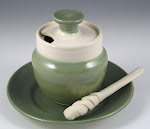I confess- I’m finding the new mayim achronim pieces kind of nice. OK, I didn’t come up with a creative variation on the traditional well-and-pitcher design. I seemed to keep coming back to this practical form. Somehow these feel true to my style, though.
Here are four of the nine sets I made this week.
When a set is put together, it measures about 8” tall from bottom of base to top of pitcher. This photo is of drying work, which will be dull in finish until glaze fired. But use your imagination to turn the clay from gray to an ivory color, deepen the underglaze colors to the strong hues they will assume when heated to maturity, and picture the shine of glossy, clear glaze over them.
Now, what should I charge for my nice, glossy little set? Competition is charging $30 for a machine-made mayim achronim.
Here is the process, from raw clay to gallery shelf: (skip 1-6 if you don't care about process!)
1) Both parts are thrown separately on the wheel, and a pouring lip formed on each pitcher. Each well is made with a little shelf inside the lip for the pitcher to sit on neatly. The mouth of the well and the bottom of the pitcher are sized to fit each other.
2) After they firm up enough, I go back on the wheel, where each piece is trimmed of any extra clay at the bottom. Once trimmed, handles are put on the pitchers.
3) Underglaze color is put on and designs cut through it, as whimsy dictates. This is fun and relaxing.
4) Kiln is loaded with the pots and fired to bisque, taking 8 hours or so to reach temperature, and unloaded when cool a day later. It is an electric kiln and doesn’t need a lot of tending.
5) Glaze is dipped over each piece, and the bottom cleaned off. Kiln is reloaded with glazed pots, fired again to a still higher temperature for about 10 hours to glaze maturity, and unloaded when cool late tomorrow.
6) Any sharp bits on bottoms are ground off with a special stone. I check pots for other flaws.
What do 1-6 mean? They say that it may take me as much as an hour and a half to make each set from start to finish.
(I will just mention some overhead costs that should go into the accounting: cost of clay and glaze materials, cost of electricity for firing the kiln twice, time spent wedging and weighing out appropriate size pieces of clay, time spent in cleanup.)
If I charge the same $30 as the machine-made competition commands, by my calculation, I would be paying myself about $20 per hour. (The overhead would subtract another couple of bucks from that.) Should I have chosen from the get-go to spend my time instead making something that is perceived to have greater inherent value, like a nice easy-to-make bowl? -I do like the challenge of making different sorts of things. Or should I have bought a different wardrobe than my mud clothes, and gotten a regular job like other people?
I would love some of your thoughts on this, my dear people with opinions.
Subscribe to:
Post Comments (Atom)


Apologies in advance for throwing in economic nerd-isms, but it seems to me that small functional Judaica is somewhat price inelastic.
ReplyDeleteWhen someone goes into a store to buy a Mayim Achronim set, they decide that they are going to buy one with little care about the price. Is it $30? OK. $40? Also ok.
This only goes so far, of course. Make it $200 and no one will shell out the money. Even $100 or $75 seems unlikely.
I think the bottom line is that you should get paid for the work that you do and people who want this will choose it whatever the price within reason. I'd say you should charge $35-40 so that you can make your hourly rate and recoup costs.
I also think you should put information about the artist and the time spent on this (or on building mad skills) near your work when it gets sold.
Regardless - Really cool item!!
Dave, You make good sense, as ever.
ReplyDeleteAnother thought to bear in mind, too, is that if I put a piece in a gallery, I will get only 50-65% of the price tag amount. My gallery pieces should not be higher price than the same type of pieces in my web site store (still developing; see www.mimistadlerpottery.com), and my web site pieces should not undercut gallery pots. I have to try to find a balanced price.
Probably, gallery pots need to be a different sort of item than my usual pieces. Hmm. More on that in another blog post, as I ponder this and try to develop some gallery pieces.I have an idea...
Pricing is a brier patch for handicraft artists. Your reasoning is sound and I like it. Thanks!
I'll leave the pricing thoughts to Dave-- but I wonder about the balance of the item. I can't see how big the shelf inside the well is, but I hope its wide, because when those pitchers have water in them, balance is going to become very important.
ReplyDeleteAnd I love the carving "as whimsy dictates!"
Zahava, the shelf inside the well is small, but measured to assure it can hold the pitcher. Also, the bottom of the pitcher is fairly flat and wide for stability. Oh, the bits of design that have to come together in a simple little pot!
ReplyDeleteSpeaking of design, maybe the next batch will have a bigger rim curving out, in case someone uses a large movement instead of a little tipping motion to rinse their fingertips.
I thought it was Mrs. Pot Lady!
ReplyDeleteI like them. They're somehow satisfying-looking, like they'd be pleasant to hold.